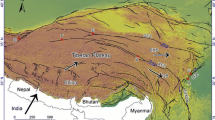Abstract
The 2013-04-20 Lushan earthquake (seismic magnitude M s 7.0 according to the State Seismological Bureau) induced a large number of landslides. In this study, spatial characteristics of landslides are developed by interpreting digital aerial photography data. Seven towns near the epicenter, with an area of about 11.11 km2, were severely affected by the earthquake, and 703 landslides were identified from April 24, 2013 aerial photography data over an area of 1.185 km2. About 55.56% of the landslide area was less than 1000 m2, whereas about 3.23 % was more than 10,000 m2. Rock falls and shallow landslides were the most commonly observed types in the study area, and were primarily located in the center of Lushan County. Most landslide areas were widely distributed near river channels and along roads.Five main factors were chosen to study the distribution characteristics of landslides: elevation, slope gradients, fault, geologic unit and river system. The spatial distribution of coseismal landslides is studied statistically using both landslide point density (LPD), defined as the number of landslides (LS Number) per square kilometer, and landslide area density (LAD), interpreted as the percentage of landslides area affected by earthquake. The results show that both LPD and LAD have strong positive correlations with five main factors. Most landslides occurred in the gradient range of 40°-50° and an elevation range of 1.0-1.5 km above sea level. Statistical results also indicate that landslides were mainly formed in soft rocks such as mudstone and sandstone, and concentrated in IX intensity areas.
Similar content being viewed by others
References
Chang M, Tang C, Li WL and Zhang DD (2013), “Image Interpretation a nd Spatial Analysis of Geohazards Induced by“4.20” Lushan Earthquake in Epicenter Area,” Journal of Chengdu University of Technology 40: 275–281. (in Chinese)
Chang M, Tang C, Zhang DD and Ma GC (2014), “Debris Flow Susceptibility Assessment Using a Probabilistic Approach: A Case Study in the Longchi Area, Sichuan Province, China,” Journal of Mountain Science, 11(4): 1001–1014.
Chen H, Dadson S and Chi YG (2006), “Recent Rainfall-Induced Landslides and Debris Flow in Northern Taiwan,” Geomorphology, 77: 112–125.
Chen X, Yu L, Wang M and Li J (2013), “Brief Communication: Landslides Triggered by the Ms = 7.0 Lushan Earthquake, China,” Nat. Hazards Earth Syst. Sci. DOI: 10.5194/nhessd-1-3891-2013.
Chigira M, Wu X, Inokuchi T and Wang G (2010), “Landslides Induced by the 2008 Wenchuan Earthquake, Sichuan, China,” Geomorphology, 118(3–4): 225–238.
Dai FC, Xu C, Yao X, Xu L, Tu XB and Gong QM (2010), “Spatial Distribution of Landslides Triggered by the 2008 Ms 8.0 Wenchuan Earthquake, China,” Journal of Asian Earth Sciences, 40: 883–895.
Forte G, Fabbrocino S, Santuccide Magistris F and Silvestri F (2013), “Seismic Permanent Ground Deformations: Earthquake Triggered Landslides in Molise Apennines,” Rend, Online Soc. Geol. It, 24: 134–136.
Kamp U, Growley BJ and Khattak GA (2008), “GISbased Landslide Susceptibility Mapping for the 2005 Kashmir Earthquake Region,” Geomorphology, 101: 631–642.
Keefer DK (2002), “Investigating Landslides Caused by Earthquakes a Historical Review,” Surveys in Geophysics, 23: 473–510.
Khattak GA, Owen LA, Kamp U and Harp EL (2010), “Evolution of Earthquake-triggered Landslides in the Kashmir Himalaya, Northern Pakistan,” Geomorphology, 115: 102–108.
Khazai B and Sitar N (2004), “Evaluation of Factors Controlling Earthquake-induced Landslides Caused by Chi-Chi Earthquake and Comparison with the Northridge and Loma Prieta Events,” Engineering Geology, 71: 79–95.
Koi T, Hotta N, Ishigaki I, Matuzaki N, Uchiyama I and Suzuki M (2008), “Prolonged Impact of Earthquake-induced Landslides on Sediment Yield in a Mountain Watershed, The Tanzawa Region, Japan,” Geomorphology, 101: 692–702.
Li Y, Wang Y, Pei X and Luo Y (2013), “Research on Tectonic Fracturing and Causative Fault of Lushan Earthquake in Sichuan, China,” Journal of Chengdu University of Technology, 40: 242–249. (in Chinese)
Lin CW, Liu SH, Lee SY and Liu CC (2006), “Impacts of the Chi-Chi Earthquake on Subsequent Rain Induced Landslides in Central Taiwan,” Engineering Geology, 86: 87–101.
Pei XJ and Huang RQ (2013), “Analysis of Characteristics of Geological Hazards by “4.20” Lushan Earthquake in Sichuan, China,” Journal of Chengdu University of Technology, 40: 257–263. (in Chinese)
Rodriguez CE, Bommer JJ and Chandler RJ (1999), “Earthquake Induced Landslides: 1980–1997,” Soil Dynamics and Earthquake Engineering, 18: 325–346.
Tang C, van Asch TWJ and Chang M (2011a), “Catastrophic Debris Flows on 13 August 2010 in the Qingping Area, Southwestern China: The Combined Effects of a Strong Earthquake and Subsequent Rainstorms,” Geomorphology, 112:1–65.
Tang C, Zhu J, Qi X and Ding J (2011b), “Landslides Induced by the Wenchuan Earthquake and a Subsequent Strong Rainfall Event: a Case Study in Beichuan Area.” Engineering Geology, 122: 22–33.
Wang E and Meng Q (2009), “Mesozoic and Cenozoic Tectonic Evolution of the Longmenshan Fault Belt,” Science in China Series D: Earth Sciences, 52: 579–592.
Wasowski J, Del Gaudio V, Pierri P and Capolongo D (2002), “Factors Controlling Seismic Susceptibility of the Sele Valley Slopes: The Case of the 1980 Irpinia Earthquake Reexamined,” Surveys in Geophysics, 23: 563–593.
Xu C and Xiao J (2013), “Spatial Analysis of Landslides Triggered by the 2013 Ms7.0 Lushan Earthquake: a Case Study of a Typical Rectangle Area in the Northeast of Taiping Town,” Seismology and Geology, 35: 436–451.
Yin YP, Wang FW and Sun P (2009), “Landslide Hazards Triggered by the 2008 Wenchuan Earthquake, Sichuan, China,” Landslides, 6:139–152.
Zhang Y, Dong S, Hou C, Shi J, Wu Z, Li H, Sun P and Li J (2013), “Seismogenic Structure of the April 20, 2013 Lushan Ms7 Earthquake in Sichuan,” Acta Geologica Sinica, 87: 633–645.
Author information
Authors and Affiliations
Corresponding author
Additional information
Supported by: Basic Work for the National Science and Technology Special Program (2011FY110100-3) and Special Research Fund for the Doctoral Program of Higher Education (20125122130001)
Rights and permissions
About this article
Cite this article
Chang, M., Tang, C., Xia, C. et al. Spatial distribution analysis of landslides triggered by the 2013-04-20 Lushan earthquake, China. Earthq. Eng. Eng. Vib. 15, 163–171 (2016). https://doi.org/10.1007/s11803-016-0313-5
Received:
Accepted:
Published:
Issue Date:
DOI: https://doi.org/10.1007/s11803-016-0313-5




